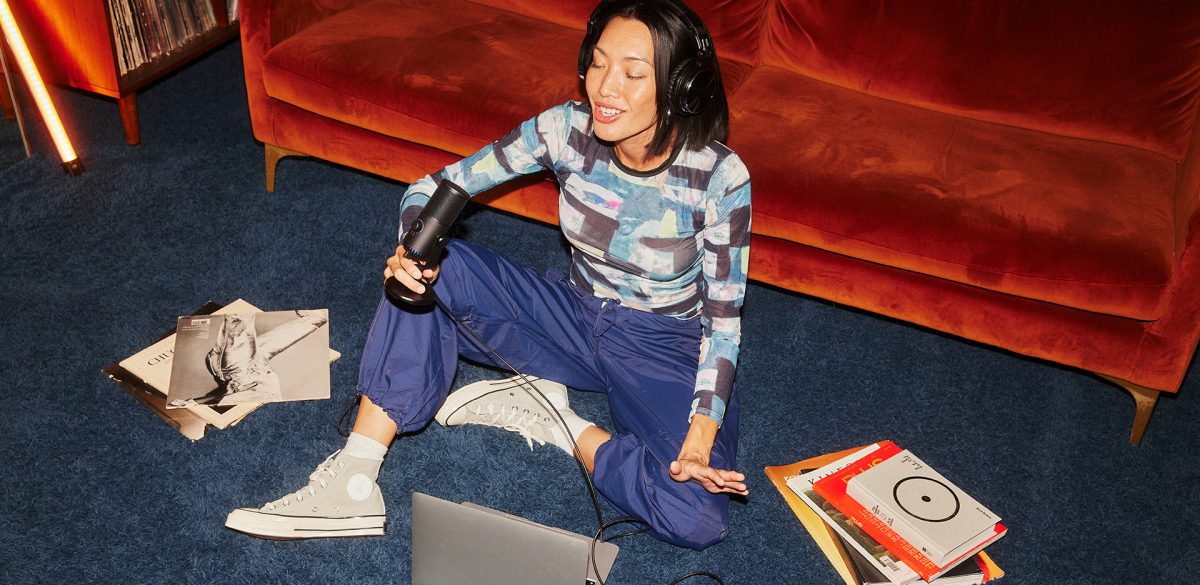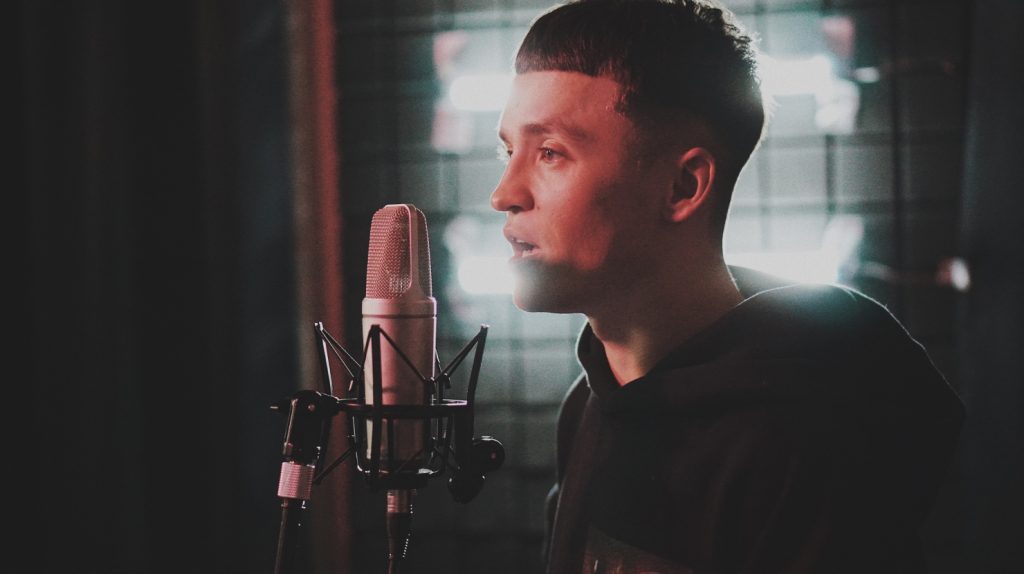
Tips For Using The Vocal Doubler In Music Mixing
Feb 23, 2024
-
Anton Berner
In this blog post, we cover everything there is to know about the useful Vocal Doubler effect in music mixing. How the effect is used in vocal production and how you can apply it in Soundtrap.
Vocal doubling is a recording technique you can use to add richness and texture to your vocals. By layering multiple vocal takes over each other, you create a fuller sound that can help the singer stand out in a mix.
This effect can be achieved naturally by recording the same part multiple times or simulating using a vocal doubler plugin.
Before we get into the details of using vocal doubler effects, let me say this: If you have the time and access to the singer to record doubles for the lead take, I recommend you start there.
That doesn’t mean using a vocal doubler is bad, though! The results can sound 100% professional, and there are some cool effects that can be achieved only by processing the vocals using a doubler.
So, if you’re working on a tight deadline and can’t get the singer back in the studio, or you’re looking for a more processed vocal sound in your mix, using a doubler effect on the vocals might just be the thing to do.
Read more: 7 Pro Tips to Get Flawless Vocal Recordings Every Time
Using a Vocal Doubler
Many vocal doubler plugins are available that make achieving this effect easier and quicker without the need for multiple takes.
With these tools, you can enhance your vocal tracks with a natural doubling effect, providing depth and space to your vocal recordings. Compatibility with modern digital audio workstations (DAWs) allows you to implement this technique with minimal effort.
Soundtrap now comes with a built-in vocal doubler effect. Its user-friendly interface will easily get you the sound of doubled voices in no time.
Understanding how to use vocal doublers effectively can dramatically improve the quality of your mixes.
Whether you are polishing vocals for a musical track, working on a podcast, or producing any other audio project, knowing how to use vocal doubling tools will elevate the listening experience and give a professional edge to your production projects.
How to use Vocal Doubler in Soundtrap
Understanding Vocal Doubling
When you’re listening to your favorite songs, have you ever noticed how some vocals seem richer and fuller? That’s often the result of vocal doubling, a technique that gives the impression of wider, deeper, and more powerful vocals.
Definition of Vocal Doubling
Vocal doubling is the process of layering two or more vocal tracks to create a fuller sound.
This can be achieved through a natural doubling effect, where the performer sings the same part multiple times or by using tools such as a vocal doubler plugin that emulates this effect.
The goal is to introduce slight timing and pitch variations that give the impression of multiple takes, which can’t be replicated by simply copying a track.
History and Evolution
The technique has come a long way since its inception. John Lennon of The Beatles famously used it, desiring the doubled sound without having to perform multiple takes. This led to the development of artificial double tracking (ADT), which automatically creates a doubled vocal effect.
Over time, advancements in technology have allowed for more precise control over the doubling effect, encapsulating the desired human variation that makes each performance unique.
The Role of Vocal Doubling in Music Production
Your goal might be to create a vocal that stands out in the mix, and that’s where vocal doubling can be indispensable. It can give the lead vocal a commanding presence in a song, especially during powerful moments such as an anthemic chorus.
By manipulating the separation and variation factors through plugins or manual tracking, you can inject life and human-like expression into your vocals, making them resonate more with listeners.
Read more: What Is Audio Sibilance and How Do You Fix It With a De-Esser?
Technical Aspects of Vocal Doublers
Vocal doublers are key tools to thicken your vocal tracks and add a lush stereo image if no real doubles are available.
How Vocal Doublers Work
Vocal doublers create the illusion that the main vocals have been performed multiple times by taking a single vocal source and replicating it. This replication is then slightly altered in time and sometimes in pitch to mimic the natural variances of a human singer.
Here’s a simple breakdown of the process:
-
Input: A vocal doubler effect plugin is enabled on your single vocal track.
-
Duplication: The software effect duplicates the vocal track to create the sound of a doubled vocal.
-
Modification: You can then modify the duplicate with slight delays, pitch variations, and changes in formant to produce a natural-sounding effect.
-
Output: The altered duplicate is mixed with the original signal to create stereo separation and a fuller sound.
The end result can make your main vocals stand out with more depth and presence.
Key Features
These are the key features of a vocal doubler effect that help you get the best sound quality:
-
Stereo Width Control: The stereo width control allows you to adjust the stereo spread for precise control over the stereo image.
-
Tone and Pitch Variation: The ability to subtly alter pitch and tone ensures the doubled vocals blend well without sounding artificial.
-
Dry/Wet Mix: This important feature allows you to balance the original and affected vocal track for the desired thickness.
Keep in mind that the goal is to enhance the vocal track without making it sound processed or overdone. When done right, the vocal doubler should add richness and texture, giving a live performance feel to your studio recording.

Vocal doublers are key tools to thicken your vocal tracks and add a lush stereo image.
Vocal Doubler Effect in Soundtrap
Soundtrap comes with its built-in vocal doubler effect. Its simple user interface is easy and fast to use for professional quality results.
The Strength slider controls how much of the doubling effect is applied to the original audio, and the Modulation slider gives you control over how much the original audio signal is modified. The Boost button can be used to give the double an additional boost of the doubling effect.
You also get a visual of how strong the doubling effect is, and this can be very helpful when dialing in the sound you want.
Read more: Pro Guide: How to Edit & Mix Your Vocals Online in 7 Steps
Popular Vocal Doubler Plugins
iZotope Vocal Doubler
iZotope offers a free plug-in aptly named Vocal Doubler. It can give your vocals a natural doubling effect, providing richness without overwhelming your mix. The interactive user interface is designed intuitively, allowing you to quickly achieve the desired double effect. It offers minimal parameter controls, ensuring a streamlined experience even for beginners.
Waves Reel ADT
The Waves Reel ADT is inspired by the vintage “artificial double tracking” technique developed at Abbey Road Studios. This plugin lets you replicate the doubling effect that was first famous for its use with The Beatles. Waves Reel ADT provides a classic sound that can be subtly or drastically applied to your vocal tracks depending on your preferences.
Soundtoys MicroShift
Soundtoys MicroShift brings the sought-after studio effect of width and space to vocals without sounding like an obvious double. This plugin uses a unique algorithm to broaden your vocals, which is especially useful if you’re aiming for lush harmonies or a rich backing chorus.
Practical Tips for Using Vocal Doublers
Using a vocal doubler can transform your vocal tracks from flat to full, adding depth and presence to your mix. This technique can help you effectively achieve a tight double, ensuring that your vocals sit perfectly at the center of the mix.
Achieving the Best Doubled Effect
A great double depends on timing and pitch variation. Start by recording a new track for a tight double and try to match the lead vocal as closely as possible. However, slight timing and pitch discrepancies enhance the doubled effect, giving a sense of thick vocals without sounding unnatural.
-
Timing Tips: Don’t perfectly align your doubles; slight delays can create a fuller sound.
-
Pitch Variation: Sing the double with minute variations in pitch to differentiate it from the lead vocal without drifting off-key.
Integrating with Virtual Instruments
When mixing a track using virtual instruments, your doubled vocals should complement the virtual elements rather than compete with them.
Here’s how:
-
Blend seamlessly: Adjust the level of your doubled vocals to sit just under the level of your virtual instruments if they occupy a similar frequency range.
-
EQ Fine-tuning: Apply EQ cuts to your virtual instruments where necessary to carve out space for the vocals. Then consider any need to apply gentle EQ boosts on your vocals so they sit naturally among the virtual instruments — emphasize highs for airiness or lows for warmth, depending on your mix’s needs.
Mixing Doubled Vocals into Your Vocal Mix
The key to integrating doubled vocals with the rest of the vocal tracks is mix control. Your doubled vocals should enhance, not overpower, the lead vocal.
-
Pan Settings: Rather than panning too widely, you might place your doubles slightly off-center to maintain focus.
-
Level Adjustments: Bring the level of the double just below the lead vocal to preserve its prominence in the mix.
-
Effects and Processing: Use reverb and delay sparingly on the double to keep the center of the mix clear for the lead.
Incorporating Vocal Doubling in Different Genres
Pop and Rock Music
In Pop and Rock music, doubling your lead vocal can add that extra punch and presence needed to make the chorus soar. Experiment with slight pitch variations and timing offsets to create a full, rich sound that cuts through the mix.
-
Pop: Use vocal layers to create a polished, radio-ready sound.
-
Rock: Try doubling or even tripling your vocal tracks for those big, anthemic hooks.
Hip-Hop and Electronic Music
Hip-Hop and Electronic genres often utilize vocal doubling to bring a unique character to the vocal line. In these genres, you might find the doubled vocals panned opposite each other to increase spatial width.
-
Hip-Hop: Apply doubling selectively on certain phrases to emphasize lyrical punchlines.
-
Electronic: Layer your background vocals subtly for a spacious and otherworldly effect.
Folk and Indie Music
Doubling vocals in Folk and Indie genres is all about subtlety. It’s less about the big sonic impact and more about enriching the emotional delivery of your songs.
-
Folk: A gentle double layered under the lead vocal can enhance storytelling.
-
Indie: Utilize a less is more approach, where minimal doubling can bring out the raw emotion.
Conclusion
Mastering the art of vocal doubling can help bring depth and richness to your vocal performances in music projects across various genres.
Nothing beats having real vocal doubles, but whether you simply don’t have access to more vocal takes or you’re after a more processed sound, leveraging the convenience of vocal doubler plugins is a solid option.
A doubler effect can help take the listening experience to another level by adding texture and dimension to vocals. These tools empower you to achieve professional-quality results without the need to record more vocal takes.
Whether you’re producing pop anthems, intimate folk ballads, or experimental electronic tracks, using vocal doublers can add depth and polish to every project.


